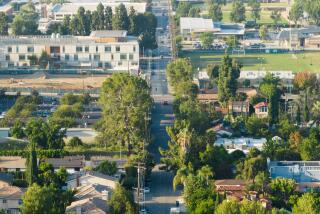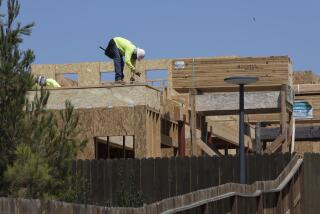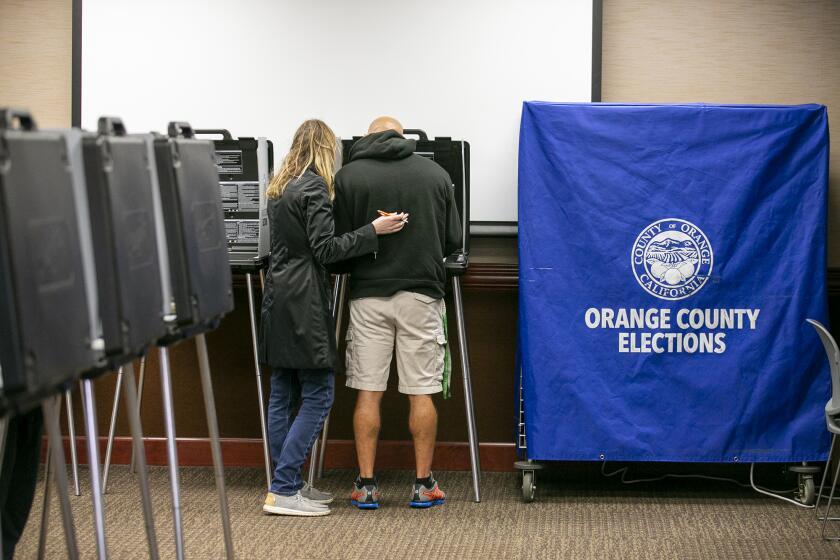A dark side to the California dream: How the state Constitution makes affordable housing hard to build
In 1950, Californians voted to put a provision in the state Constitution that makes it harder for poor people to find a place to live.
Article 34, which remains in effect, requires voter approval before public housing is built in a community. At the time it passed, the real estate industry argued taxpayers should have a right to vote on low-income housing projects because they were publicly funded infrastructure similar to schools or roads. The campaign also appealed to racist fears about integrating neighborhoods and featured heated rhetoric about the need to combat socialism.
The rule stymied low-income home construction in California for decades, including a decision to abandon public housing in Los Angeles’ Chavez Ravine neighborhood and build Dodger Stadium instead. Article 34 also weakened efforts to integrate suburban communities across the state and led to a landmark U.S. Supreme Court case that had the effect of allowing government policies nationwide that discriminate against poor people.
”We know the roots of where it came from,” Los Angeles Mayor Eric Garcetti said. “It’s a white supremacist chapter in the state’s history.”
Garcetti is behind a new effort to ask voters to repeal Article 34, mostly as a way to erase what many see as a stain on California’s Constitution. Other states have had — and repealed — laws that called for a public vote before the construction of low-income housing. But no other state constitution similarly requires voter approval for public housing, according to the California Constitution Center at UC Berkeley’s law school.
Today, as the state grapples with an unprecedented affordable housing shortage, Article 34 has limited effects on the construction of low-income developments. But it remains an obstacle: Los Angeles officials believe that without a public vote in the coming years, the city will no longer be able to finance such projects — even though it has the money to do so.
State Sen. Ben Allen (D-Santa Monica) has introduced legislation to put the repeal before voters. If it goes on a 2020 statewide ballot, it would be the fourth time Californians would consider changing or doing away with Article 34. Three prior efforts, including the most recent in 1993, failed by wide margins with opponents arguing that residents should have the right to keep public housing out of their neighborhoods.
But Allen believes the electorate has changed since the last attempt. In the past few years, voters have supported tax increases and bond measures to help support low-income and homeless housing.
Article 34, Allen said, “is an anachronistic barrier that stands in the way of that.”
Article 34 grew out of a fight in the northern coastal city of Eureka. Residents there collected signatures to overturn a decision to build public housing financed by a federal program inaugurated during the New Deal. But in 1950, the state Supreme Court ruled the acceptance of federal dollars wasn’t subject to a referendum and residents couldn’t block the development.
The California Real Estate Assn., the forerunner of today’s California Assn. of Realtors, came up with a ballot initiative later that year to combat the Eureka decision and require a public vote before public housing could be built.
Realtors argued that residents should be able to weigh in on such a project because it could create taxpayer debt.
But the campaign, which coincided with the start of the Korean War, was about more than giving voters a say. In the Realtors’ internal newsletter, Charles B. Shattuck, the organization’s legislative committee chairman, wrote that public housing threatened capitalism.
“If you value your property, if you hold liberty dear, if you believe in the dignity of the individual, if you love this land of the free and the home of the brave, if you desire to stop the enemy of socialism that is gnawing at the vitals of America from within, the ballot box is your weapon, the one and only means by which our great Republic will be preserved and improved,” Shattuck wrote in November 1950.
Newspaper ads paid for by the Realtors also blamed “minority pressure groups” for pushing public housing. At the time, the Realtors’ Code of Ethics included a provision barring agents from integrating neighborhoods on the basis of “race or nationality” if doing so would be “clearly detrimental to property values.”
The initiative passed by fewer than 50,000 votes.
In Los Angeles, residents supported Article 34 by an overwhelming margin. The city was planning to build 10,000 units of public housing, and the success of the statewide measure buoyed opponents who agitated for a referendum on the projects the city had already approved.
The resulting election in 1952 ended in a rejection of public housing, and plunged city politics into chaos.
A top official in the city’s public housing department was fired after an accusation that he was a communist and was later called to testify before state and federal Un-American Activities committees. The pro-public housing mayor lost his reelection bid. And the city canceled two planned developments, including one in which residents were already being displaced in the Mexican American community of Chavez Ravine on a site that eventually became Dodger Stadium.
The disputes chilled attempts to build public housing in Los Angeles, which did not hold another Article 34 referendum for more than two decades.
Los Angeles wasn’t the only city where Article 34 thwarted public housing. By 1969, voters across the state had turned down nearly half the public housing that had been proposed in Article 34 elections — 15,000 units — and many housing agencies didn’t hold elections, fearing that their plans would be rejected. A federal Department of Housing and Urban Development report at the time found that California had the nation’s largest population of poor people but ranked 22nd in the amount of housing available for them. The report blamed Article 34.
Those opposed to public housing were often open about their reasons. In 1968, San Jose City Councilwoman Virginia Shaffer led a campaign against a series of publicly funded duplexes and small apartments in her city, telling a reporter that some poor people “drag the whole neighborhood down.”
“People oppose public housing because too often it means there will be piles of garbage, trash, knee-high grass and undisciplined children in a neighborhood where other people are trying to meet their payments,” Shaffer said.
The San Jose vote failed, prompting a legal challenge to Article 34. The lawsuit argued that it violated the U.S. Constitution’s Equal Protection Clause by denying poor people access to housing.
The case made its way to the U.S. Supreme Court, where in 1971 justices affirmed Article 34’s constitutionality. In the majority opinion, Justice Hugo Black agreed that Article 34 put low-income residents at a disadvantage, but wrote it did not violate the Constitution because the provision didn’t single out a racial group.
“Provisions for referendums demonstrate devotion to democracy, not to bias, discrimination or prejudice,” Black wrote.
The Supreme Court decision was consequential, said Matthew Lassiter, a history professor at the University of Michigan and an expert in the growth of the U.S. suburbs. The ruling had the effect of affirming state and local policies that were openly biased against poor people, he said. Soon afterward, President Richard Nixon released a statement that embraced the decision’s logic, saying that the federal government would not impose economic integration on cities and counties.
“The Supreme Court case is one of the most important defeats in civil rights history in the last century, and is under-appreciated in how much it contributed to the stoppage of efforts to integrate communities across the country,” Lassiter said.
Lassiter also was critical of the ruling for overlooking Article 34’s racial implications. Racial discrimination in housing was legal until 1968, and in decades prior, the federal government had guaranteed bank loans to developers of white-only subdivisions, promoted the use of racially restrictive covenants on deeds to prevent people of color from buying homes and subsidized white residents’ mortgages but not others. The policies gave whites access to wealth through homeownership that others didn’t have.
Blocking low-income housing, Lassiter said, had the consequence of keeping most non-whites from living in those areas as well.
“To say it was not about race is to say history doesn’t matter and there was this magic historical moment where all vestiges of a racialized housing market went away and everything started anew like the Book of Genesis,” Lassiter said.
The Supreme Court decision returned the focus to California.
On three occasions, state lawmakers have asked voters to rescind or weaken Article 34. In 1974, a repeal failed by 24 percentage points. Six years later, legislators put forward a proposition so that residents could appeal a decision to build public housing instead of holding an automatic vote. That measure lost by an even greater margin. Then, in 1993, lawmakers tried again with a proposition that would have kept Article 34 on the books, but exempted almost all projects from its rules.
This time, the measure was supported by the California Assn. of Realtors — the group behind the original push for Article 34. It didn’t matter. Opponents, including a state senator from northern Los Angeles and an Orange County assemblyman, contended in the official voter guide that Article 34 was a success because it prevented public housing from being built.
“Why should we trust politicians and special interests to protect our local neighborhoods and spend our tax dollars wisely?” they wrote.
Nearly 60% voted no.
Article 34 is much less of a barrier to low-income housing construction than it used to be. Over the years, funding sources for such projects have changed. When private developers set aside a portion of homes in a project for low-income residents or housing is funded by federal or state tax credits, a vote is not required.
Courts have also decided that local governments can hold elections to authorize an overall number of public housing units to be built in future years rather than go to voters for each individual project. And residents became friendlier to Article 34 elections, with around 80% of referenda approved by the early 1990s, according to a report by the state Department of Housing and Community Development.
Still, the provision continues to be an obstacle for some low-income homebuilding. Affordable housing developers structure deals to avoid triggering a vote — legal and consulting costs can be in the tens of thousands of dollars — or must ensure that a city has enough units approved from a prior Article 34 election. But when a local government hits its cap, it must again seek approval from voters.
That’s happening in Los Angeles. A 2008 ballot measure approved by voters allowed up to 3,500 public housing units per council district in the city. Some neighborhoods are now close to their limit. City officials believe they’ll have to hold another vote within the next couple years to increase the cap, prompting Garcetti to instead pitch a repeal of Article 34 to the Legislature.
Garcetti also said he takes issue with the argument that low-income housing should be subject to a public vote because it involves spending government money. Taxpayer subsidies for homeowners, through the mortgage interest deduction and other means, long have dwarfed the public funding available for low-income housing development.
“We have done a much better job helping middle-class, upper-middle-class and wealthy Californians with housing subsidies than we have for working-class residents,” Garcetti said.
But a repeal of Article 34 is hardly a sure thing, said former State Treasurer Phil Angelides, who worked on one of the failed efforts to weaken it. Angelides called the provision “a blot on the [state] Constitution,” but said, on its face, a requirement to hold a public vote doesn’t seem like it might have negative effects.
“While it’s clearly discriminatory, it has the aura of local control, which is something people like in California,” Angelides said. “It’s going to take a campaign of informing voters what it means.”
Coverage of California politics »
More to Read
Get the L.A. Times Politics newsletter
Deeply reported insights into legislation, politics and policy from Sacramento, Washington and beyond. In your inbox three times per week.
You may occasionally receive promotional content from the Los Angeles Times.







